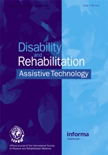
Disability and Rehabilitation-Assistive Technology
Scope & Guideline
Fostering Innovation in Disability and Assistive Solutions
Introduction
Aims and Scopes
- Assistive Technology Development and Evaluation:
The journal publishes research on the design, development, and evaluation of assistive technologies, including devices for mobility, communication, and daily living activities. This includes studies on usability, effectiveness, and user satisfaction. - Rehabilitation Practices and Technologies:
Research focusing on integrating assistive technologies within rehabilitation practices to enhance recovery and functional independence for individuals with disabilities. This includes interventions using virtual reality, robotics, and telehealth. - User-Centered Design and Accessibility:
Emphasis on the importance of user-centered design principles in creating accessible assistive technologies that meet the needs of diverse populations, including children, elderly, and individuals with varying disabilities. - Socioeconomic and Policy Perspectives:
Exploration of the socioeconomic factors influencing access to assistive technologies, including policy implications and service delivery models aimed at improving equity in access. - Innovations in Digital Health:
The journal examines the role of digital health technologies, such as mobile health applications and telehealth, in supporting individuals with disabilities and promoting their engagement in health and rehabilitation processes.
Trending and Emerging
- Smart and Connected Assistive Devices:
There is a notable increase in research on smart devices and the Internet of Things (IoT) applications in assistive technology, focusing on how these innovations can enhance user independence and improve rehabilitation outcomes. - Telehealth and Remote Rehabilitation:
The impact of telehealth technologies, particularly in the context of the COVID-19 pandemic, has gained considerable attention, with studies exploring their effectiveness and feasibility for delivering rehabilitation services. - Multidisciplinary Collaboration in Assistive Technology:
Emerging research emphasizes the importance of multidisciplinary collaboration in the design and implementation of assistive technologies, integrating insights from various fields to enhance the user experience. - User-Centered and Participatory Design Approaches:
A growing trend in research focuses on participatory design methodologies that actively involve users in the development process of assistive devices, ensuring that their needs and preferences shape the final products. - Mental Health and Assistive Technology:
An increasing number of papers explore the intersection of mental health and assistive technology, investigating how these tools can support emotional well-being and social interaction for individuals with disabilities.
Declining or Waning
- Traditional Mobility Devices:
Research focusing solely on traditional mobility devices, such as standard wheelchairs, has seen a decline as the field shifts towards more innovative and technology-integrated solutions like smart wheelchairs and robotic mobility aids. - General Disability Awareness and Advocacy:
Papers that broadly discuss disability awareness and advocacy without a specific focus on assistive technology or rehabilitation practices have decreased, indicating a more focused approach on practical applications and technologies. - Single-Domain Interventions:
Studies that explore single-domain interventions without integrating assistive technology or multidisciplinary approaches are becoming less common, as there is a growing emphasis on comprehensive, multi-faceted solutions. - Basic Rehabilitation Techniques:
Research centered on traditional rehabilitation techniques without the incorporation of assistive technology or innovative methods has diminished, reflecting a shift towards incorporating modern technology in rehabilitation practices.
Similar Journals

Universal Access in the Information Society
Advancing digital inclusivity in today's information landscape.Universal Access in the Information Society is a distinguished academic journal published by SPRINGER HEIDELBERG, focusing on the critical fields of computer networks, human-computer interaction, information systems, and software. Established in 2003, this periodical aims to disseminate innovative research that tackles the challenges of universal access to information and communication technologies, making it a vital resource for researchers, professionals, and students dedicated to enhancing digital inclusivity. With a commendable impact reflected in its Scopus rankings, it places in the second quartile for Computer Networks and Communications and Information Systems, as well as in the third quartile for Human-Computer Interaction, verifying its pivotal role in advancing knowledge within these domains. Although currently not open access, the journal offers comprehensive insights that are essential for anyone looking to contribute to or comprehend the evolving landscape of information societal access. The journal's commitment to bridging knowledge gaps makes it indispensable for both academic and practical applications in the Information Society.
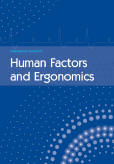
International Journal of Human Factors and Ergonomics
Innovating Human-Centric Solutions for Complex SystemsWelcome to the International Journal of Human Factors and Ergonomics, a premier platform dedicated to the exploration and advancement of research in the increasingly vital fields of human factors and ergonomics. Published by INDERSCIENCE ENTERPRISES LTD, this journal serves an international audience of researchers, practitioners, and students, facilitating the dissemination of knowledge that aims to enhance the interaction between people and systems. With its ISSN 2045-7804 and E-ISSN 2045-7812, the journal actively contributes to the academic community's understanding of human capabilities and limitations, striving to improve product design, work environments, and overall usability. Despite its classification in Q4 of the 2023 Human Factors and Ergonomics category and a Scopus ranking reflecting the competitive landscape—where it stands at #37 out of 46 in its field—the journal is committed to building a strong foundation of evidence-based practices through rigorous peer-reviewed articles. Through its convergence efforts from 2016 to 2024, it aims to bridge theoretical research with practical applications to promote safety, efficiency, and user satisfaction across various domains.
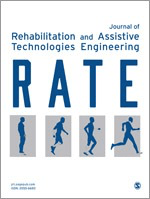
Journal of Rehabilitation and Assistive Technologies Engineering
Pioneering New Frontiers in Rehabilitation TechnologyJournal of Rehabilitation and Assistive Technologies Engineering, published by SAGE PUBLICATIONS INC, is a leading interdisciplinary journal dedicated to advancing the field of rehabilitation and assistive technologies. With an emphasis on innovative research and practical applications, this journal seeks to bridge the gap between theoretical advancements and real-world implementations, making it essential reading for researchers, healthcare professionals, and students alike. The Journal of Rehabilitation and Assistive Technologies Engineering aims to disseminate high-quality findings that enhance the quality of life for individuals with disabilities through improved technologies and rehabilitation techniques. Although it is not an open access journal, it maintains a robust impact factor reflecting its significance in the field. By focusing on collaboration between various disciplines, the journal encourages fresh perspectives and solutions that can lead to breakthroughs in assistive technology. For those looking to stay informed about the latest research and developments, this journal is a vital resource.
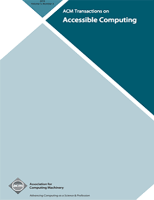
ACM Transactions on Accessible Computing
Advancing inclusivity in technology.ACM Transactions on Accessible Computing, with ISSN 1936-7228 and E-ISSN 1936-7236, is a prestigious journal published by the Association for Computing Machinery. Established to advance the field of accessible computing, this journal plays a critical role in promoting research that enhances the usability of computer technology for individuals with diverse accessibility needs. Its impact is reflected in its 2023 Scopus rankings, placing it in the Q2 category for Computer Science Applications and Q3 for Human-Computer Interaction, making it a significant resource for researchers and practitioners alike. With an ongoing publication timeline from 2008 through 2024, the journal not only contributes to theoretical advancements but also addresses practical implications in the realm of inclusive design and innovation. Although not Open Access, the journal is a vital forum for disseminating cutting-edge research, ensuring that advancements in technology are accessible to all.
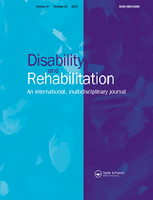
DISABILITY AND REHABILITATION
Advancing Knowledge to Enhance Disability Solutions.Disability and Rehabilitation, a prestigious journal published by Taylor & Francis Ltd, plays a critical role in the field of rehabilitation science. Since its inception in 1978, this journal has been dedicated to presenting high-quality research focused on improving the lives of individuals with disabilities through innovative rehabilitation techniques and healthcare solutions. With an impressive Q1 ranking in the Rehabilitation category and a Scopus rank of #24 out of 161, the journal is recognized for its significant impact and rigorous scholarly contributions, boasting an 85th percentile performance among peers. Although it operates under a subscription model, the journal remains a vital resource for researchers, healthcare professionals, and students seeking the latest insights and developments in the realm of disability and rehabilitation. Covering a broad spectrum of topics, from clinical practices to theoretical advancements, Disability and Rehabilitation continues to shape the future of rehabilitation research and practice worldwide.

JMIR Aging
Connecting Knowledge with Geriatric ExcellenceJMIR Aging is a premier open-access journal published by JMIR Publications, Inc., dedicated to advancing the field of aging research and geriatric care. Established in 2018, this journal has quickly achieved a reputation for excellence, currently holding a Q1 ranking in several categories, including Geriatrics and Gerontology, Health Informatics, and Health (Social Science), reflecting its high impact and significant contributions to these fields. With a strong focus on innovative research that bridges technology and aging populations, JMIR Aging provides a platform for interdisciplinary collaboration among researchers, healthcare professionals, and students. The journal is indexed in Scopus, where it ranks impressively across various health science categories, underscoring its influence and reach within the academic community. Accessible to all, JMIR Aging plays a vital role in disseminating critical knowledge and fostering discussions that can lead to improved health outcomes for aging individuals worldwide.

Archives of Rehabilitation Research and Clinical Translation
Pioneering Discoveries in Rehabilitation ScienceArchives of Rehabilitation Research and Clinical Translation, published by ELSEVIER, is a leading open access journal dedicated to advancing the field of rehabilitation research and clinical practice. Since its inception in 2019, the journal has made significant contributions to the understanding of rehabilitation methodologies and interventions, showcasing innovative research that bridges the gap between clinical practices and rehabilitation science. With an impressive impact factor and essential Scopus rankings—#56 in Rehabilitation Medicine and #94 in Physical Therapy—this journal is highly regarded in its fields and reaches a diverse international audience. The open access format promotes widespread dissemination of scholarly work, ensuring that vital research findings are accessible to all practitioners, researchers, and students worldwide. As a trusted platform for high-quality research, the journal encourages rigorous scientific exploration and fosters collaboration among professionals striving to improve the quality of rehabilitation services.
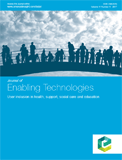
Journal of Enabling Technologies
Bridging Technology and Human PotentialThe Journal of Enabling Technologies, published by EMERALD GROUP PUBLISHING LTD, stands as a pivotal resource within the realms of Computer Science Applications, Health (Social Science), and Management of Technology and Innovation. Established in 2017 and converging towards its 2024 target, the journal has garnered significant recognition, reflected in its Q3 classification in multiple categories for 2023 and a commendable Q2 ranking in Rehabilitation. It holds respectable standings in Scopus rankings, notably positioning itself at the 38th percentile in Rehabilitation and 71st in Health Social Sciences. Aimed at promoting knowledge and innovation, the journal serves as an essential platform for researchers, professionals, and students, enabling them to explore advancements, share insights, and foster interdisciplinary collaboration. Although it does not offer open access, its impact factor and authoritative standing in the field underscore its importance for anyone dedicated to enhancing technology utilization across these vital sectors.

ERGONOMICS
Bridging the gap between people and their environments.ERGONOMICS is a premier journal that serves the dynamic fields of Human Factors and Ergonomics, as well as Physical Therapy, Sports Therapy, and Rehabilitation. Published by Taylor & Francis Ltd in the United Kingdom, this journal not only boasts a commendable impact factor but also holds a Q2 quartile ranking across its categories, underscoring its influence and academic rigor. With a convergence of significant research dating back to 1957, ERGONOMICS provides a multifaceted platform for the dissemination and discussion of innovative findings that enhance the interaction between people and their environments. Although the journal does not offer Open Access options, it remains a vital resource for researchers, professionals, and students seeking to deepen their understanding of ergonomic principles and applications. Positioned at the intersection of health and human behavior, ERGONOMICS is dedicated to advancing knowledge and promoting best practices in an era where the demand for safe and efficient work environments continues to grow.

ADVANCED ROBOTICS
Pioneering Innovation in Robotics ResearchADVANCED ROBOTICS is a premier journal published by Taylor & Francis Ltd that has been at the forefront of robotics research since its inception in 1986. With an esteemed ISSN of 0169-1864 and E-ISSN of 1568-5535, this journal offers a unique platform for disseminating high-quality research across diverse domains within the robotics field, encompassing applications in Computer Science, Control and Systems Engineering, Hardware and Architecture. Ranked in the Q2 quartile across multiple categories in 2023, ADVANCED ROBOTICS maintains a reputable standing in the academic community, emphasizing its commitment to advancing knowledge and innovation. Although not an Open Access publication, the journal’s access options ensure that subscribers can explore the latest findings and engage with prominent experts in the field, facilitating an enriching exchange of ideas. Researchers, professionals, and students alike will find ADVANCED ROBOTICS an invaluable resource for keeping abreast of developments and contributing to the ever-evolving landscape of robotics.